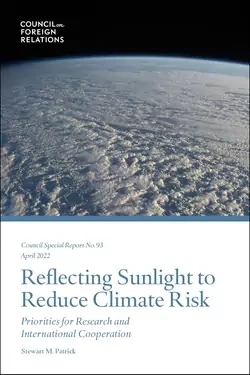
Reflecting Sunlight to Reduce Climate Risk
Priorities for Research and International Cooperation

Reflecting sunlight should be considered a potential stopgap for rising global temperatures, argues Stewart M. Patrick.
- Council Special Report
- Concise policy briefs that provide timely responses to developing crises or contributions to current policy dilemmas.
“For too long, the topic of sunlight reflection has been a third rail of climate change discourse, limiting both basic research and diplomatic discussion. That situation is starting to change as the devastating implications of a fast-warming planet become impossible to ignore,” asserts Senior Fellow Stewart M. Patrick in a new Council Special Report, Reflecting Sunlight to Reduce Climate Risk: Priorities for Research and International Cooperation.
Sunlight reflection, also known as solar geoengineering, involves reflecting sunlight back into space to reduce rising temperatures on Earth. The simplest and most cost-effective methods are either dispersing aerosols in the stratosphere (mimicking the effects of volcanic eruptions that have periodically blocked sunlight and cooled the planet) or using ocean salt crystals to make low-lying clouds brighter and more reflective—a process called marine cloud brightening.
More on:
Patrick—senior fellow in global governance and director of the International Institutions and Global Governance program at the Council on Foreign Relations—warns that “the long-predicted climate emergency is now,” and “the approaches currently being pursued to prevent catastrophic warming and mute its implications are not being enacted fast enough.”
There are three main approaches to managing risks from the changing climate: reducing emissions; removing carbon dioxide from the atmosphere; and adapting to build resilience and minimize the effects of a warming planet. Patrick finds that “although efforts to decarbonize have begun in many countries, global emissions continue to rise. The shift to renewable energy . . . is happening far too slowly to prevent significant warming by midcentury, and adaptation has its own limitations.”
Patrick argues there is a fourth “potentially fast-acting, low-cost, and high-leverage way to limit increasing global temperatures and their attendant effects. That method is sunlight reflection.” According to Patrick, it would be “a stopgap strategy to ‘shave the peak’ of anticipated warming and its effects, buying time for more durable solutions” such as emissions reduction, decarbonization, and adaptation to progress and scale up.
The author acknowledges that sunlight reflection is untested, under-researched, and involves the use of techniques that are susceptible to human error and unintended consequences. At best, it would be an imperfect and partial response to climate change. Nevertheless, he says, its risks and possibilities should be investigated, analyzed, and weighed against the known dangers of climate change, given the escalating threat to both social and natural systems posed by rising temperatures.
To this end, the author calls for the creation of a well-funded and effectively organized U.S. national research program, grounded in close international cooperation, to carefully consider the deployment of sunlight reflection as a tool in the climate change arsenal.
More on:
He further recommends the United States strive for international agreement on the norms and rules that govern any actual application of sunlight reflection techniques. Without strong international cooperation, he warns, there is a growing danger that individual governments may take matters into their own hands, with potentially negative geopolitical consequences.
“It would be vastly preferable for the world to make progress on the science of sunlight reflection and to discuss its national and international governance openly today, so that policymakers are prepared to make informed decisions on its potential deployment tomorrow, rather than being forced to act out of ignorance on the fly when all other options have failed,” Patrick concludes.
Professors: To request an exam copy, contact [email protected]. Please include your university and course name.
Bookstores: To order bulk copies, please contact Ingram. Visit https://ipage.ingramcontent.com, call 800.937.8200, or email [email protected]. Include ISBN: 978-0-87609-449-5.
 Online Store
Online Store